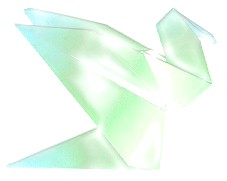
We already mentioned the crane as an omnipresent symbol in Japanese culture.
In more serious
circumstances, this very optimistic symbol is always accompanied with wishes for a healthy
and long life.
From the Second World War on the crane also became a symbol of peace…

The story of Sadako Sasaki is at the origin of this symbol. Sadako was a little child that became a victim of radioactive radiation after the bomb on Hiroshima. While she was in the hospital she folded cranes out of the small sheets of paper that contained her medicines. She was told: "Once you have been able to fold a thousand cranes, you will be healed."
Folding the cranes, she prayed for her unlucky friends. But, after her 644th crane, she died; her friends completed the number and… From all over Japan young children began to fold cranes to express the longing for world peace.
The Children's Peace Monument - erected in 1958 in the Hiroshima Peace Memorial Parc - is therefore called Tower of a Thousand Cranes.